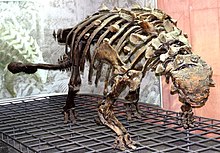Ankylosaurine
| Ankylosaurids Temporal range: Early Cretaceous - Late Cretaceous, 122–66 Ma |
|
|---|---|
 |
|
| Mounted skeleton of Euoplocephalus tutus, Senckenberg Museum | |
| Scientific classification | |
| Kingdom: | Animalia |
| Phylum: | Chordata |
| Class: | Reptilia |
| Clade: | Dinosauria |
| Order: | †Ornithischia |
| Suborder: | †Ankylosauria |
| Family: |
†Ankylosauridae Brown, 1908 |
| Type species | |
|
†Ankylosaurus magniventris Brown, 1908 |
|
| Subfamilies | |
|
†Ankylosaurinae Brown, 1908 |
|
| Synonyms | |
|
Syrmosauridae Maleev, 1952 |
|
†Ankylosaurinae Brown, 1908
Syrmosauridae Maleev, 1952
The armored dinosaurs of Ankylosauridae (/,ænkaɪloʊsɔːrɪdaɪ/ or /,ænkaɪloʊsɔːrɪdi:/) are a family within Ankylosauria, and sister group to Nodosauridae. Ankylosaurids appeared 122 million years ago and went extinct 66 million years ago during the Cretaceous–Paleogene extinction event. These animals were mainly herbivorous and were obligate quadrupeds, with leaf-shaped teeth and robust, scute-covered bodies. Ankylosaurids possess a distinctly domed and short snout, wedge-shaped osteoderms on their skull, scutes along their torso, and a tail club.
Ankylosauridae is exclusively known from the northern hemisphere, with specimens found in western North America, Europe, and East Asia. The first discoveries within this family were of the genus Ankylosaurus, by Peter Kaiser and Barnum Brown in Montana in 1906.
Ankylosaurids are stout, solidly built, armoured dinosaurs. They possess accessory ossifications on cranial bones that cover some skull openings and form wedge-shaped, horn-like structures. Along the ankylosaurid torso are scute rows, which are filled in with smaller ossicles to create a fused shield of armour. Only two collars of armour plates can be found on the neck, as opposed to the sister group, nodosaurids, which have three. Nodosauridae and Ankylosauridae also share the unique attribute of abundant structural fibres in both primary and secondary bone. Ankylosaurids also have an S-shaped narial passage.
The most distinguishing feature of ankylosaurids is the presence of a tail club. It is made out of modified interlocking distal caudal vertebrae and enlarged, bulbous osteoderms. The “handle” of the tail club involves the vertebrae, and requires elongated prezygapophyses to overlap at least half of the preceding vertebral centrum length. These distal caudal vertebrae also lack transverse processes and neural spines, and therefore tend to be longer than they are wide; the reverse is true for proximal caudal vertebrae. Derived ankylosaurids possess a fusion of posterior dorsal, sacral, and sometimes anterior caudal vertebrae, which forms a singular structure called a “synsacrum complex”. There is a complete fusion between centra, neural arches, zygapophyses, and sometimes neural spines.
...
Wikipedia
